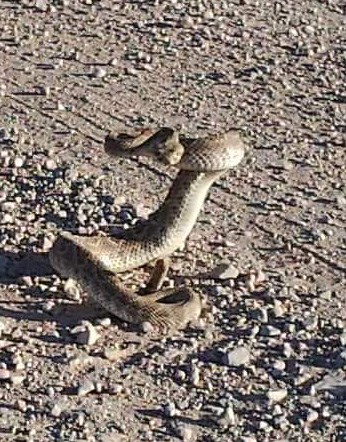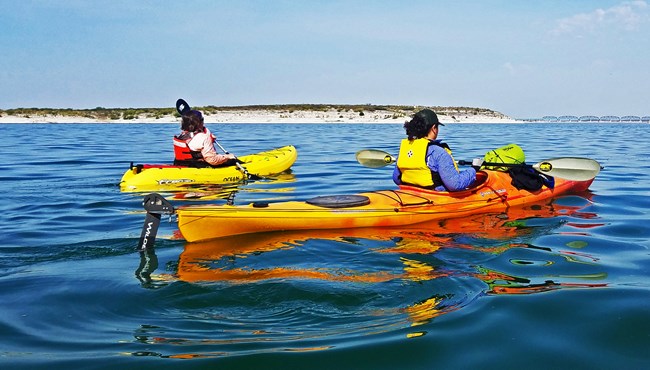
NPS / JC Frost The National Park Service invites you to Plan like a Park Ranger in preparation for your big adventure at Amistad National Recreation Area. Being prepared will help keep you safe and enjoying all that this great park has to offer. Check ahead to see what the current conditions are for weather and environment at the park and have an action plan for any unexpected weather, like thunderstorms. Follow the seven Leave No Trace principles to help keep the park safe and unimpared for the enjoyment of future generations, as well. While the following list is not all-inclusive, it will help with some special considerations for your trip planning. AnimalsIn general, animals in national parks are protected from being fed and harassed. Furthermore, even the most harmless-looking animals can injure a person or spread disease. So, it is important to use the "Rule of Thumb." If you see an animal, back up slowly until you can cover your entire view of the animal with your thumb held at full arm's-length (and a few extra steps wouldn't hurt). WaterThough it can be easy to forget with the reservoir being a highlight, Amistad National Recreation Area is in a desert biome. The desert is an extreme environment. Carry enough water, about one gallon per person per day even in the winter, and drink water before you feel thirsty. Water is available at Visitor Center, Diablo East, and Governors Landing, but also come prepared and bring water with you to the park. Do not drink untreated water, as it can make your situation worse if you become ill due to naturally occuring bacteria. Eating salty snacks will help replenish the salts that are sweated out and help make sweating more effective. 
Centers for Disease Control and Prevention Weather-related IllnessesHeat ExhaustionHeat exhaustion occurs when the body loses more fluid than is taken in. Signs of heat exhaustion can include some or all of the following: nausea, vomiting, fatigue/weakness, lightheadedness/fainting, headache, pale appearance, muscle cramps, fast and weak pulse, and cool and clammy skin. If a member of your party begins to experience any of these symptoms, stop your activity immediately. In most cases, you can treat heat exhaustion yourself by doing the following:
If you don't begin to feel better within one hour of using these treatment measures or you feel worse or start to vomit, seek medical attention immediately. Heat StrokeHeat stroke is an advanced stage of heat exhaustion. It is the body's inability to cool itself. Symptoms include high body temperature (103 degrees Fahrenheit or higher), dry and flushed/reddened skin, confusion, nausea/vomiting, altered mental state (i.e., disorientation, confusion, agitation, irritability), behavioral changes (i.e., slurred speech, delirium, staggering), rapid heartbeat or breathing, and seizures or coma. If you believe that a member of your party is suffering from heat stroke, it is imperative to cool them using any available means and obtain immediate medical assistance. Heat stroke is a medical emergency. HypothermiaHypothermia occurs when the body is cooled to dangerous levels. It is responsible for the greatest number of deaths among people engaging in outdoor activities. Possible even in warm weather, hypothermia often occurs without the victim's awareness. It is a hazard on the lake because immersion in water is the quickest way to lose body heat. To prevent hypothermia, avoid cotton clothing (it provides no insulation when wet) and eat high-energy food before you are chilled. The signs of hypothermia include uncontrollable shivering, stumbling and poor coordination, fatigue, and confusion or slurred speech. If you recognize any of these signs, stop what you are doing and immediately replace wet clothing with dry clothing. It may also be necessary to warm the person and move them out of the wind. 
NPS / J. Johnson Additional Safety Considerations by ActivityBoatingBoating is one of the most popular activities at Amistad National Recreation Area. The number of boaters on the lake can vary from just a handful to over 200 when there is a large fishing tournament going on. Remember to follow these safety tips when boating on the reservoir:
DrivingEvery year, white-tailed deer and other wildlife are killed by vehicles on the roads surrounding Amistad National Recreation Area. Please drive with caution, especially from sunset to sunrise when animals are more active along roads, ambient light is minimal, and drivers (you or others) are more likely to be tired or sleepy. Always wear safety belts and use child safety seats. HikingHiking is one of the many recreational activities that is available at Amistad National Recreational Area. There are several designated hiking trails throughout the park. Remember a well-planned hike is a safe hike.
SwimmingThere are no lifeguards at Amistad National Recreation Area. Swim at your own risk. The National Park Service recommends that everyone, especially children and those with limited or no swimming experience wear USCG-approved personal floatation devices (PFDs) appropriate to the activity at all times when in and around water and along shorelines. |
Last updated: April 21, 2025
